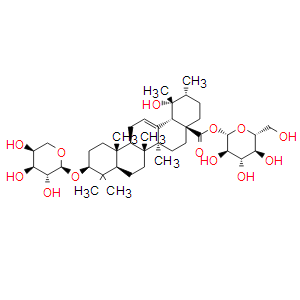| Cas No.: | 35286-58-9 |
| SMILES: | OC[C@@H](O[C@H]1OC([C@@]23[C@]([H])(C4=CC[C@]5([H])[C@]6(C)[C@@]([H])(CC[C@]5([C@]4(C)CC3)C)C([C@@H](O[C@H]7[C@H](O)[C@@H](O)[C@@H](O)CO7)CC6)(C)C)[C@]([C@H](C)CC2)(C)O)=O)[C@@H](O)[C@H](O)[C@H]1O |
| Formula: | C41H66O13 |
| M.Wt: | 766.959 |
| Purity: | >98%, Standard References Grade |
| Sotrage: | 4°C for 1 year, -20°C for more than 2 years |
| Description: | Ziyuglycoside I isolated from S. officinalis root, has anti-wrinkle activity, and increases the expression of type I collagen. Ziyuglycoside I could be used as an active ingredient for cosmetics[1].Ziyuglycoside I triggers cell cycle arrest and apoptosis mediated by p53, it can be a potential drug candidate for treating triple-negative breast cancer (TNBC)[2]. |
| In Vitro: | Ziyuglycoside I (5-160 µM; 24 hours) reveals a marked anti-proliferation activity with an IC50 value of 13.96 µM in MDA-MB-231 cells[2]. Ziyuglycoside I (5-20 µM; 24 hours) induces MDA-MB-231 cell apoptosis by increasing the percentage of apoptotic cells from 2.43% to 44.76% at 20 µM[2]. Ziyuglycoside I (5-20 µM; 24 hours) induces the cleavage of caspas-8, caspase-9, and caspase-3, up-regulates the pro-apoptotic protein Bax, and down-regulates anti-apoptotic protein Bal-2, dose-dependently reduces the level of mito-cyto c expression[2]. Cell Viability Assay[1] Cell Line: MDA-MB-231 cells Concentration: 5 µM, 10 µM, 20 µM, 40 µM, 80 µM, and 160 µM Incubation Time: 24 hours Result: Showed cytotoxicity on MDA-MB-231 cells. Cell Cycle Analysis[1] Cell Line: MDA-MB-231 cells Concentration: 5 µM, 10 µM, and 20 µM Incubation Time: 24 hours Result: Induced G2/M phase arrest and apoptosis on MDA-MB-231 Cells Western Blot Analysis[1] Cell Line: MDA-MB-231 cells Concentration: 5 µM, 10 µM, and 20 µM Incubation Time: 24 hours Result: Induced apoptosis in MDA-MB-231 Cells through Intrinsic and Extrinsic Pathways. |
| References: | [1]. Kim YH, et al. Anti-wrinkle activity of ziyuglycoside I isolated from a Sanguisorba officinalis root extract and its application as a cosmeceutical ingredient. Biosci Biotechnol Biochem. 2008 Feb;72(2):303-11. Epub 2008 Feb 7. [2]. Zhu X, et al. Ziyuglycoside I Inhibits the Proliferation of MDA-MB-231 Breast Carcinoma Cells through Inducing p53-Mediated G2/M Cell Cycle Arrest and Intrinsic/Extrinsic Apoptosis. Int J Mol Sci. 2016 Nov 22;17(11). pii: E1903 |

 To enhance service speed and avoid tariff delays, we've opened a US warehouse. All US orders ship directly from our US facility.
To enhance service speed and avoid tariff delays, we've opened a US warehouse. All US orders ship directly from our US facility.




















